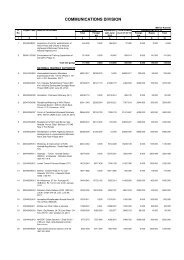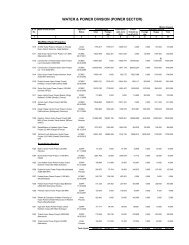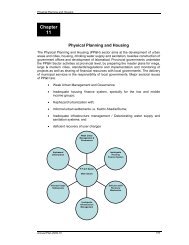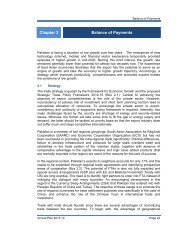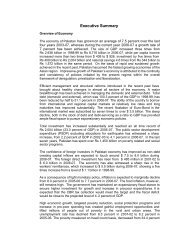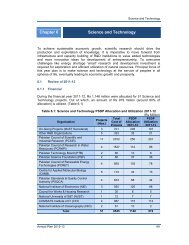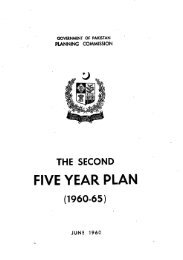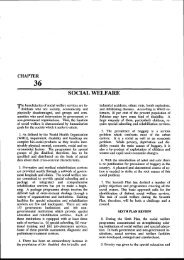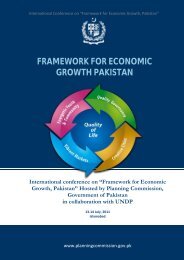Manual for Development Projects - Planning Commission
Manual for Development Projects - Planning Commission
Manual for Development Projects - Planning Commission
You also want an ePaper? Increase the reach of your titles
YUMPU automatically turns print PDFs into web optimized ePapers that Google loves.
Chapter 5<br />
Domestic PW of domestic currency cost of Official<br />
Resource = realizing <strong>for</strong>eign exchange saving x Echange<br />
Exchange<br />
PW of net <strong>for</strong>eign exchange<br />
saving<br />
Cost expressed in local currency<br />
5.16 Now the domestic resource cost calculated through the above <strong>for</strong>mula is say Rs 23.65 and the official<br />
exchange rates Rs 22 per US $. It shows that domestic resource cost is higher than the prevailing official<br />
exchange rate and we are spending more than a dollar to produce a dollar worth of item at home than to import it.<br />
In case the domestic resource cost is less than the official exchange rate, it implies that the project is using less<br />
domestic resources to save or earn a unit of <strong>for</strong>eign exchange and thus the project is economically justified.<br />
5.17 In the social sectors, we per<strong>for</strong>m unit cost analysis. The only method used to any extent to deal with<br />
intangible benefits is to determine, on a present worth basis, the least expensive alternative combination of<br />
tangible costs that will realize essentially the same intangible benefits. This is often referred to as "least-cost<br />
combination" or cost effectiveness. Economists have tried to quantify the intangible benefits. The benefits of<br />
education have been valued by comparing the earnings of an educated man with those of one who is uneducated.<br />
Health and sanitation benefits have been valued in the number of hours of lost work avoided by<br />
decreasing the incidence of disease. Nutrition benefits have been valued in terms of increased productivity.<br />
Population projects have been valued by attaching a value to the births. But these valuations are highly<br />
questionable. In cost analysis, we only take the cost side - that is, the cost-stream on training, capital cost, O&M<br />
cost, replacement cost and salvage value (negative cost) is discounted at the opportunity cost to find the annual<br />
financial cost/subsidy and unit cost. In case of a health project, the unit cost will be cost per bed; in case of an<br />
education project, it will be cost per student; and in case of a housing project, it will be cost per square foot. In<br />
housing projects, the calculation of the standard rent of residential quarters is also an important job. In unit cost<br />
analysis, those projects which have a relatively lower unit cost than that of other projects of the same kind are<br />
favoured.<br />
5.18 Various concepts used in project appraisal have been discussed earlier in this chapter. A set of practical<br />
discounted measures of project worth are as follows:-<br />
Financial Analysis Economic Analysis<br />
(a) Discounted measures (a) Adjustment in prices<br />
i) Present Worth of Cost (PWC), Present Worth of<br />
Benefit cial Capital Cost into (PWB), Net Present<br />
Value Economic Cost.<br />
(NPV), Benefit-Cost Ratio<br />
(BCR) at given discount rate.<br />
i) Trans<strong>for</strong>mation of Finan-<br />
ii) Internal Financial Rate ofReturn (IFRR) ii)<br />
Trans<strong>for</strong>mation of Financial and Operation &<br />
Maintenance (O&M) costs into Economic Cost.<br />
iii) Return on Equity after taxes. iii) Benefits Valued at Border prices.<br />
iv) Return on Equity be<strong>for</strong>e taxes.<br />
(b) Sensitivity Analysis (b) Discounted Measures<br />
i) PWC, NPV, BCR & IFRR with cost over-run,<br />
reduction in benefits and delay in realization of<br />
benefits.<br />
http://hd2/pc/popup/ch5_p.html<br />
i) PWC, PWB, NPV & BCR at<br />
given discount rate.<br />
Rate<br />
Page 12 of 24<br />
9/23/2010




